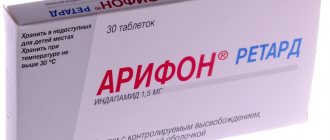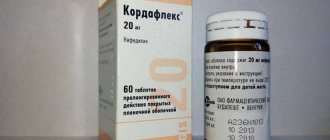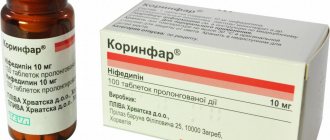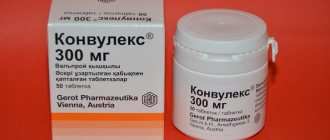Klabaks OD prolong tablets 500 mg No. 14
Pharmacodynamics
Clarithromycin is metabolized in the cytochrome P4503A (CYP3A) system of the liver.
Absolute bioavailability is about 50%. With repeated administration of the drug, no accumulation was detected and the nature of metabolism in the human body does not change. Clarithromycin binds to plasma proteins by 70% at concentrations from 0.45 to 4.5 μg/ml. At a concentration of 45 μg/ml, binding decreases to 41%, probably as a result of saturation of binding sites. This is observed only at concentrations many times higher than the therapeutic value.
Taking extended-release clarithromycin orally at a dose of 500 mg per day allows you to maintain equilibrium levels of maximum concentrations of clarithromycin and 14-hydroxyclarithromycin in the blood plasma. The steady-state Cmax of clarithromycin and 14-hydroxyclarithromycin in plasma is 1.3 and 0.48 mcg/ml, respectively. T1/2 of the parent drug and its main metabolite are 5.3 and 7.7 hours, respectively. When taking extended-release clarithromycin orally at a dose of 1000 mg per day (2 tablets of 500 mg each), the equilibrium Cmax levels of clarithromycin and 14-hydroxyclarithromycin are in an average of 2.4 and 0.67 μg/ml, respectively. T1/2 of the parent drug and its main metabolite are 5.8 and 8.9 hours, respectively. The Tmax value when taking doses of 500 and 1000 mg per day is about 6 hours. At steady state, the level of 14-hydroxyclarithromycin does not increase in proportion to the doses of clarithromycin, and T1/2 of clarithromycin and its main metabolite increase with increasing dose. The nonlinear nature of the pharmacokinetics of clarithromycin is associated with a decrease in the formation of 14-hydroxylated and N-demethylated metabolites when using higher doses, which indicates the nonlinearity of the metabolism of clarithromycin when taking high doses.
About 40% of the clarithromycin dose is excreted in the urine, and about 30% through the intestines.
Clarithromycin and 14-hydroxyclarithromycin are widely distributed in tissues and body fluids. After oral administration of clarithromycin, its content in the cerebrospinal fluid remains low (with normal BBB permeability of 12% of serum levels). The content in tissues is usually several times higher than the content in blood serum.
Liver dysfunction. In patients with moderate to severe impairment of liver function, but with preserved renal function, no dose adjustment of clarithromycin is required. The equilibrium plasma concentration and systemic clearance of clarithromycin do not differ between patients in this group and healthy patients. The steady-state concentration of 14-hydroxyclarithromycin in people with impaired liver function is lower than in healthy people.
Renal dysfunction. If renal function is impaired, the minimum and maximum levels of clarithromycin in the blood plasma, T1/2, AUC of clarithromycin and 14-hydroxyclarithromycin increase. The elimination constant and urinary excretion decrease. The degree of change in these parameters depends on the degree of renal dysfunction.
Elderly patients. In elderly patients, blood levels of clarithromycin and 14-hydroxyclarithromycin were higher and elimination was slower than in the younger group. It is believed that changes in pharmacokinetics in elderly patients are associated primarily with changes in creatinine clearance and renal function, and not with the age of the patients.
Klabax OD, 500 mg, extended-release film-coated tablets, 14 pcs.
Clarithromycin is metabolized in the cytochrome P4503A (CYP3A) system of the liver. Absolute bioavailability is about 50%. With repeated administration of the drug, no accumulation was detected and the nature of metabolism in the human body does not change.
Clarithromycin binds to plasma proteins by 70% at concentrations from 0.45 to 4.5 μg/ml. At a concentration of 45 μg/ml, binding decreases to 41%, probably as a result of saturation of binding sites. This is observed only at concentrations many times higher than the therapeutic value.
Taking extended-release clarithromycin orally at a dose of 500 mg per day allows you to maintain equilibrium levels of maximum concentrations of clarithromycin and 14-hydroxyclarithromycin in the blood plasma. The steady-state Cmax of clarithromycin and 14-hydroxyclarithromycin in plasma is 1.3 and 0.48 mcg/ml, respectively. T1/2 of the parent drug and its main metabolite are 5.3 and 7.7 hours, respectively. When taking extended-release clarithromycin orally at a dose of 1000 mg per day (2 tablets of 500 mg each), the equilibrium Cmax levels of clarithromycin and 14-hydroxyclarithromycin are in an average of 2.4 and 0.67 μg/ml, respectively. T1/2 of the parent drug and its main metabolite are 5.8 and 8.9 hours, respectively. The Tmax value when taking doses of 500 and 1000 mg per day is about 6 hours. At steady state, the level of 14-hydroxyclarithromycin does not increase in proportion to the doses of clarithromycin, and T1/2 of clarithromycin and its main metabolite increase with increasing dose. The nonlinear nature of the pharmacokinetics of clarithromycin is associated with a decrease in the formation of 14-hydroxylated and N-demethylated metabolites when using higher doses, which indicates the nonlinearity of the metabolism of clarithromycin when taking high doses.
About 40% of the clarithromycin dose is excreted in the urine, and about 30% through the intestines.
Clarithromycin and 14-hydroxyclarithromycin are widely distributed in tissues and body fluids. After oral administration of clarithromycin, its content in the cerebrospinal fluid remains low (with normal BBB permeability - 1-2% of the level in the blood serum). The content in tissues is usually several times higher than the content in blood serum.
Liver dysfunction.
In patients with moderate to severe impairment of liver function, but with preserved renal function, no dose adjustment of clarithromycin is required. The equilibrium plasma concentration and systemic clearance of clarithromycin do not differ between patients in this group and healthy patients. The steady-state concentration of 14-hydroxyclarithromycin in people with impaired liver function is lower than in healthy people.
Renal dysfunction.
If renal function is impaired, the minimum and maximum levels of clarithromycin in the blood plasma, T1/2, AUC of clarithromycin and 14-hydroxyclarithromycin increase. The elimination constant and urinary excretion decrease. The degree of change in these parameters depends on the degree of renal dysfunction.
Elderly patients.
In elderly patients, blood levels of clarithromycin and 14-hydroxyclarithromycin were higher and elimination was slower than in the younger group. It is believed that changes in pharmacokinetics in elderly patients are associated primarily with changes in creatinine clearance and renal function, and not with the age of the patients.
Side effects of the drug Acid OD
In most cases, Klabax is well tolerated. Nausea, vomiting, diarrhea, abdominal pain, stomatitis, glossitis, candidal stomatitis, discoloration of the tongue, headache, arthralgia, myalgia, and rarely allergic reactions (from minor skin rashes and urticaria to anaphylaxis) may occur. Cases of the development of Stevens-Johnson syndrome and thrombocytopenia have been described. There may be cases of taste disturbances and changes in the color of teeth, isolated cases of hypoglycemia (mainly in patients who were simultaneously taking oral hypoglycemic drugs or insulin), leukemia and thrombocytopenia. Transient CNS side effects have been reported: anxiety, dizziness, insomnia, convulsions, hallucinations and impaired consciousness. In isolated cases, the use of clarithromycin was accompanied by the development of pseudomembranous colitis (from mild to life-threatening). Liver dysfunction of varying severity, altered laboratory results, cholestasis with or without jaundice, and hepatitis have been reported. There have been isolated reports of increased serum creatinine levels, the development of interstitial nephritis, renal failure, and pancreatitis. As with the use of other macrolides, the use of clarithromycin has in rare cases been associated with prolongation of the QT , the development of ventricular tachycardia and ventricular fibrillation-flutter.
Indications for use of the drug Acid OD
Infections caused by microorganisms sensitive to Klabax: sinusitis, pharyngitis, otitis media, infections of the lower respiratory tract (pneumonia, acute and chronic bronchitis); disseminated mycobacterial infections caused by Mycobacterium avium or Mycobacterium intracellulare ; skin and soft tissue infections; myco- and ureaplasmosis, chlamydia; in complex therapy for the eradication of Helicobacter pylori in patients with peptic ulcers of the stomach and duodenum. Klabax can be used in the complex treatment of leprosy and toxoplasmosis.
Instructions for use of Klabax
| Active substance | Clarithromycin |
| pharmachologic effect | Bacteriostatic; Bactericidal |
| Vacation conditions | Prescription |
| Release form | Film-coated tablets |
| Pregnancy and breastfeeding | Contraindicated in the first trimester; According to indications in the II and III trimester |
| Age group | 12+ |
| Best before date | 3 years |
| Storage conditions | Not higher than +25 °C |
| Analogs | Bacticap; Zimbaktar; Clubax OD; Clarbuckt; Clarexide; Clarithromycin; Clarithromycin SR; Clarithrosin; Claricin; Klasine; Klacid; Klacid SR; Clerimed; Seydon-Sanovel; Fromilid; Fromilid UNO |
| Category | Antibacterial drugs |
| Manufacturer | RANBAXY LABORATORIES (India) |
| Price | from 224 rub. |
Directions for use and dosage
The duration of treatment with the antibiotic Klabaks depends on the indications.
When taken orally for adults and children over 12 years of age:
A single dose is 0.25-1 g, dosage frequency is 2 times a day.
For children under 12 years old:
The daily dose of Klabax is 7.5-15 mg/kg/day in 2 divided doses.
In children, clarithromycin should be used in the appropriate dosage form intended for this category of patients.
Patients with impaired renal function (creatinine clearance less than 30 ml/min or serum creatinine level more than 3.3 mg/dl):
The dose of Klabaks should be reduced by 2 times or the interval between doses should be doubled.
Maximum daily doses: for adults – 2 g, for children – 1 g.
Compound
Klabaks film-coated tablets:
Active ingredient: Clarithromycin 250 mg and 500 mg.
The structural formula of Clarithromycin is C38H69NO13. Photo: wikipedia.org
Indications for use
Treatment of infectious and inflammatory diseases caused by pathogens sensitive to clarithromycin:
- infections of the upper respiratory tract and ENT organs (tonsillopharyngitis, otitis media, acute sinusitis);
- infections of the lower respiratory tract (acute bronchitis, exacerbation of chronic bronchitis, community-acquired bacterial and atypical pneumonia);
- odontogenic infections; skin and soft tissue infections;
- mycobacterial infections (M.avium complex, M.kansasii, M.marinum, M.leprae) and their prevention in AIDS patients;
- eradication of Helicobacter pylori in patients with duodenal or gastric ulcer (only as part of combination therapy).
Contraindications
- a history of QT interval prolongation, ventricular arrhythmia, or torsade de pointes;
- hypokalemia (risk of QT interval prolongation);
- severe liver failure occurring simultaneously with renal failure;
- history of cholestatic jaundice/hepatitis that developed while using clarithromycin;
- porphyria;
- I trimester of pregnancy;
- lactation period (breastfeeding);
- simultaneous use of clarithromycin with astemizole, cisapride, pimozide, terfenadine;
- with ergot alkaloids, for example, ergotamine, dihydroergotamine;
- with midazolam for oral administration;
- with HMG-CoA reductase inhibitors (statins), which are largely metabolized by the CYP3A4 isoenzyme (lovastatin, simvastatin), with colchicine;
- with ticagrelor or ranolazine;
- hypersensitivity to clarithromycin and other macrolides.
Side effects
- From the digestive system: often – diarrhea, vomiting, dyspepsia, nausea, abdominal pain; uncommon – esophagitis, gastroesophageal reflux disease, gastritis, proctalgia, stomatitis, glossitis, bloating, constipation, dry mouth, belching, flatulence, increased concentration of bilirubin in the blood, increased activity of ALT, AST, GGT, alkaline phosphatase, LDH, cholestasis, hepatitis , incl. cholestatic and hepatocellular; frequency unknown - acute pancreatitis, discoloration of the tongue and teeth, liver failure, cholestatic jaundice.
- Allergic reactions: often - rash; uncommon – anaphylactoid reaction, hypersensitivity, bullous dermatitis, itching, urticaria, maculopapular rash; frequency unknown - anaphylactic reaction, angioedema, Stevens-Johnson syndrome, toxic epidermal necrolysis, drug rash with eosinophilia and systemic symptoms (DRESS syndrome).
- From the nervous system: often – headache, insomnia; uncommon – loss of consciousness, dyskinesia, dizziness, drowsiness, tremor, anxiety, increased excitability; frequency unknown - convulsions, psychotic disorders, confusion, depersonalization, depression, disorientation, hallucinations, nightmares, paresthesia, mania.
- From the skin: often – intense sweating; frequency unknown – acne, hemorrhages.
- From the senses: often – dysgeusia; uncommon – vertigo, hearing loss, ringing in the ears; frequency unknown - deafness, ageusia, parosmia, anosmia.
- From the cardiovascular system: often – vasodilation; uncommon – cardiac arrest, atrial fibrillation, prolongation of the QT interval on the ECG, extrasystole, atrial flutter; frequency unknown - ventricular tachycardia, incl. "pirouette" type.
- From the urinary system: infrequently - increased creatinine concentration, change in urine color; frequency unknown - renal failure, interstitial nephritis.
- From the side of metabolism and nutrition: infrequently - anorexia, decreased appetite, increased urea concentration, change in the albumin-globulin ratio.
- From the musculoskeletal system: uncommon – muscle spasm, musculoskeletal stiffness, myalgia; frequency unknown - rhabdomyolysis, myopathy.
- From the respiratory system: infrequently - asthma, nosebleeds, pulmonary embolism.
- From the hematopoietic system: infrequently – leukopenia, neutropenia, eosinophilia, thrombocythemia; frequency unknown - agranulocytosis, thrombocytopenia.
- From the blood coagulation system: infrequently - increase in MHO value, prolongation of prothrombin time.
- Infectious and parasitic diseases: infrequently - cellulitis, candidiasis, gastroenteritis, secondary infections (including vaginal); frequency unknown - pseudomembranous colitis, erysipelas.
- Local reactions: very often - phlebitis at the injection site, often - pain at the injection site, inflammation at the injection site.
- From the body as a whole: infrequently - malaise, hyperthermia, asthenia, chest pain, chills, fatigue.
pharmachologic effect
Klabax is a semi-synthetic antibiotic of the macrolide group. Suppresses protein synthesis in microbial cells by interacting with the 50S ribosomal subunit of bacteria. It acts mainly bacteriostatically and also bactericidally.
The antibiotic Klabaks is active against gram-positive aerobic microorganisms - Staphylococcus aureus, Streptococcus pyogenes, Streptococcus pneumonia, Listeria monocytogenes; aerobic gram-negative microorganisms – Haemophilus influenzae, Haemophilus parainfluenzae, Moraxella (Branhamella) catarrhalis, Neisseria gonorrhoea, Legionella pneumophila, Helicobacter pylori; predominantly intracellular microorganisms - Mycoplasma pneumonia, Chlamydia pneumonia (TWAR), Mycobacterium leprae, Mycobacterium kansaii, Mycobacterium chelonae, Mycobacterium fortitum, Mycobacterium avium complex (MAC) - a complex including Mycobacterium avium, Mycobacterium intracellulare.
Under in vitro conditions, clarithromycin is active against most strains of the following microorganisms: aerobic gram-positive microorganisms - Streptococcus agalactiae, Streptococci (groups C, F, G), Streptococcus viridans; aerobic gram-negative microorganisms – Bordetella pertussis, Pasteurella multocida, Campylobacter jejuni; anaerobic gram-positive microorganisms – Clostridium perfringens, Peptococcus niger, Propionibacterium acnes; anaerobic gram-negative microorganisms – Bacteroides melaninogenicus; spirochetes – Borrelia burgdorferi, Treponema pallidum.
Most strains of staphylococci resistant to methicillin and oxacillin are also resistant to clarithromycin.
Precautionary measures
Use of Klabaks during pregnancy and breastfeeding
- Use in the first trimester of pregnancy is contraindicated.
- Use in the second and third trimesters of pregnancy is possible only in cases where the expected benefit to the mother outweighs the potential risk to the fetus.
- If necessary, use during lactation should stop breastfeeding.
Application of Klabax for liver dysfunction
Contraindicated in severe liver failure, hepatitis (history).
Use of Klabaks for renal dysfunction
In patients with impaired renal function (creatinine clearance less than 30 ml/min or serum creatinine level more than 3.3 mg/dl), the dose should be halved or the interval between doses should be doubled.
Use of Klabax in children
Currently, there is insufficient data on the effectiveness and safety of clarithromycin in children under 6 months of age.
Special instructions:
Clarithromycin should be used with caution in patients with moderate to severe renal impairment; moderate to severe liver failure, with ischemic heart disease, severe heart failure, hypomagnesemia, severe bradycardia (less than 50 beats/min); simultaneously with benzodiazepines, such as alprazolam, triazolam, midazolam for intravenous administration; simultaneously with other ototoxic drugs, especially aminoglycosides; simultaneously with drugs that are metabolized by CYP3A isoenzymes (including carbamazepine, cilostazol, cyclosporine, disopyramide, methylprednisolone, omeprazole, indirect anticoagulants, quinidine, rifabutin, sildenafil, tacrolimus, vinblastine; simultaneously with CYP3A4 inducers (including rifampicin , phenytoin, carbamazepine, phenobarbital, St. John's wort); simultaneously with statins, the metabolism of which does not depend on the CYP3A isoenzyme (including fluvastatin); simultaneously with blockers of slow calcium channels, which are metabolized by the CYP3A4 isoenzyme (including verapamil, amlodipine, diltiazem); simultaneously with class IA (quinidine, procainamide) and class III antiarrhythmic drugs (dofetilide, amiodarone, sotalol).
- Cross-resistance is observed between macrolide antibiotics.
- Antibiotic treatment alters the normal intestinal flora, so superinfection caused by resistant microorganisms may develop.
- It should be borne in mind that severe persistent diarrhea may be due to the development of pseudomembranous colitis.
- Prothrombin time should be periodically monitored in patients receiving clarithromycin concomitantly with warfarin or other oral anticoagulants.





